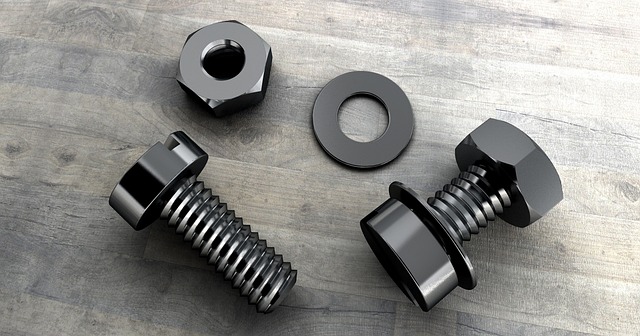Robotics in Manufacturing: Increasing Efficiency and Accuracy

Are you tired of the inefficiencies and errors that plague traditional manufacturing processes? Well, brace yourself for an exciting revolution: robotics in manufacturing. This cutting-edge technology is transforming the industry, boosting efficiency, and enhancing accuracy like never before.
Picture this: a bustling factory floor where robots seamlessly carry out repetitive tasks with precision and lightning speed. These mechanical marvels are designed to perform a wide range of functions, from assembly and welding to packaging and quality control. With their robotic arms and sensors, they navigate through complex procedures effortlessly, leaving human workers in awe of their capabilities.
One of the key advantages of robotics in manufacturing is the significant increase in efficiency. Unlike humans, robots don’t tire or require breaks. They can work tirelessly around the clock, maximizing productivity and reducing production time. This means faster turnaround on orders and shorter lead times, giving manufacturers a competitive edge in today’s fast-paced market.
Moreover, robots have an uncanny ability to perform tasks with unparalleled accuracy. Their precision is unmatched, ensuring consistent results every time. Whether it’s assembling intricate components or conducting quality inspections, robots excel at maintaining strict tolerances and minimizing defects. This leads to higher product quality, fewer rejections, and ultimately, happier customers.
But it doesn’t stop there. Robotics in manufacturing also brings about cost savings. While the initial investment may be significant, the long-term benefits outweigh the costs. Robots eliminate the need for extensive human labor, reducing overhead expenses associated with wages, training, and benefits. Additionally, with improved accuracy, there is less material waste and lower rework costs, further optimizing the bottom line.
Furthermore, integrating robotics into the manufacturing process enhances workplace safety. Dangerous tasks that pose risks to human workers can be assigned to robots, mitigating potential injuries and accidents. This fosters a safer working environment and promotes employee well-being.
In summary, the advent of robotics in manufacturing is revolutionizing the industry. It is driving efficiency, accuracy, cost savings, and safety to unprecedented heights. With robots as invaluable allies, manufacturers are poised to meet the demands of a rapidly evolving market while delivering superior products. So, buckle up and embrace this exciting new era of manufacturing, where the future is in the hands of robots.
Revolutionizing the Assembly Line: How Robotics is Boosting Manufacturing Efficiency to Unprecedented Levels

Are you tired of the same old manufacturing processes that take forever and result in costly errors? Well, get ready to be amazed because robotics is revolutionizing the assembly line, taking manufacturing efficiency to unprecedented levels. In this article, we’ll explore how robots are transforming the manufacturing industry and the incredible benefits they bring.
Gone are the days when human workers had to tirelessly perform repetitive tasks on the assembly line. With the introduction of robotics, factories are experiencing a seismic shift in efficiency. Robots work tirelessly, tirelessly, never tiring, never making mistakes, and never needing breaks. They can perform intricate tasks with precision and speed, surpassing what humans could achieve.
Imagine a future where robots seamlessly collaborate with human workers, each complementing the other’s strengths. This collaboration has become a reality in many manufacturing facilities. Robots handle the heavy lifting, tedious tasks, and dangerous operations, while humans focus on innovation, problem-solving, and overseeing the overall process. The result? A harmonious symphony of efficiency and productivity.
The impact of robotics on manufacturing efficiency is truly remarkable. These machines can work 24/7 without fatigue, significantly reducing production time. They have unmatched accuracy, eliminating errors and defects caused by humans. By streamlining the assembly line, robots optimize workflow, minimize downtime, and increase throughput. This translates into cost savings and improved profitability for manufacturers.
Moreover, robots are flexible and adaptable, capable of swiftly switching between different tasks and product variations. They can be easily reprogrammed and reconfigured to accommodate changes in production requirements, making them invaluable in today’s fast-paced manufacturing landscape. With robots at the helm, manufacturers can swiftly respond to market demands and stay ahead of the competition.
Robotics has brought a paradigm shift to the manufacturing industry, revolutionizing the assembly line and boosting efficiency to unprecedented levels. From increased productivity to improved quality control, the benefits are undeniable. As technology continues to advance, we can expect even more remarkable innovations that will reshape the way we manufacture products. So, buckle up and embrace the robotic revolution. The future of manufacturing is here, and it’s incredible!
Precision Redefined: How Robotics in Manufacturing is Transforming Accuracy Standards
In today’s fast-paced world, precision and accuracy are paramount in the manufacturing industry. With the advent of robotics, a new era of accuracy standards has emerged. This article delves into the transformative power of robotics and its impact on precision in manufacturing processes.
Robots have revolutionized the way products are made, ensuring unparalleled precision throughout the production line. These automated wonders possess exceptional dexterity and consistency, capable of performing repetitive tasks with extraordinary accuracy. By employing advanced sensors, computer vision, and machine learning algorithms, robots can make minute adjustments and maintain precise measurements throughout the manufacturing process.

Imagine a robot meticulously assembling intricate components of a smartphone or a delicate surgical instrument. With their precise movements and real-time feedback systems, robots eliminate the risk of human error, resulting in higher-quality products. From automotive assembly lines to electronics manufacturing, robots have redefined the meaning of precision.
One of the key advantages of robotics in manufacturing is their ability to achieve consistent accuracy over extended periods. Unlike human workers who may experience fatigue or inconsistency, robots tirelessly execute tasks with unwavering precision. They follow predefined algorithms and perform tasks within extremely tight tolerances, ensuring every product meets the desired specifications.
Moreover, robots excel at performing complex operations that require extreme precision, such as laser cutting, welding, and 3D printing. These tasks demand meticulous attention to detail, which robots deliver flawlessly. With their ability to operate in hazardous environments or handle toxic substances, robots not only enhance precision but also ensure the safety of human workers.
The impact of robotics on precision extends beyond individual tasks. Collaborative robots, or cobots, work alongside human operators, combining human intelligence with robotic precision. This synergy allows for efficient and accurate completion of complex tasks, enabling manufacturers to achieve even greater levels of precision and productivity.
Robotics has revolutionized accuracy standards in the manufacturing industry. With their unwavering precision, consistency, and ability to perform intricate tasks, robots have redefined what it means to achieve accuracy in manufacturing processes. As technology continues to advance, we can expect robotics to play an increasingly vital role in the pursuit of precision and excellence in manufacturing.
From Human Hands to Robotic Precision: Exploring the Role of Automation in Streamlining Manufacturing Processes
In today’s rapidly evolving world, automation is revolutionizing the manufacturing industry. Gone are the days when manual labor was the primary force driving production. Instead, sophisticated machines and robots have taken center stage, bringing unprecedented precision and efficiency to manufacturing processes. This article delves into the pivotal role that automation plays in streamlining modern manufacturing.
Imagine a moment where human hands gracefully pass the baton to robotic precision. Automation has ushered in a new era, where repetitive and mundane tasks are relinquished to tireless machines. These advanced systems possess the ability to perform intricate operations with immense accuracy, ensuring that every product meets stringent quality standards. By eliminating human errors and inconsistencies, manufacturers can now deliver flawless goods consistently.

One might wonder, how does automation accomplish such remarkable feats? The answer lies in the integration of cutting-edge technologies. Robotics, artificial intelligence (AI), and machine learning work in tandem to optimize manufacturing processes. Robots equipped with sensors and AI algorithms can adapt to changing production requirements swiftly. They can analyze vast amounts of data, make real-time decisions, and adjust their actions accordingly. This flexibility allows manufacturers to respond to market demands swiftly, reducing turnaround times and staying ahead of the competition.

Automation not only enhances precision but also maximizes productivity. In the past, manual labor would be limited by physical limitations, such as fatigue or injuries. However, robots tirelessly carry out repetitive tasks 24/7 without succumbing to exhaustion. With increased production speeds and round-the-clock operation, businesses can meet growing consumer demands efficiently.
Moreover, automated manufacturing processes optimize resource utilization. By minimizing material waste and energy consumption, companies can reduce costs significantly. Robots precisely measure and control the usage of raw materials, ensuring minimal wastage while maintaining consistent quality. This eco-friendly approach not only benefits the bottom line but also contributes to a sustainable future.
The integration of automation into manufacturing processes has brought about a paradigm shift. From human hands to robotic precision, this transformation has revolutionized the industry. By leveraging advanced technologies, businesses can achieve unparalleled levels of precision, efficiency, and productivity. The role of automation in streamlining manufacturing processes cannot be overstated—it is driving innovation, improving quality, and setting new benchmarks for the industry as a whole.
Unleashing the Power of AI: How Robotics is Driving Efficiency Gains in Manufacturing
Have you ever imagined a world where robots work side by side with humans, seamlessly increasing efficiency and productivity? Well, that future is now becoming a reality, thanks to the incredible advancements in Artificial Intelligence (AI) and robotics. In the manufacturing industry, AI-powered robots are transforming the way things get done, revolutionizing processes, and driving significant efficiency gains.
Picture this: a bustling manufacturing floor with robots meticulously performing tasks that were once solely done by human hands. These robots, equipped with advanced AI algorithms, have the ability to analyze vast amounts of data, make complex decisions, and adapt to changing circumstances in real-time. They are capable of learning from their experiences and continuously improving their performance. This infusion of AI into robotics has unlocked a whole new level of efficiency and precision in manufacturing.

One area where AI-driven robotics is making a tremendous impact is in repetitive and labor-intensive tasks. These tasks, although essential, can be monotonous and prone to errors when performed by humans. By automating these processes with AI-powered robots, manufacturers can achieve unparalleled accuracy and consistency, significantly reducing the margin for error. Moreover, robots do not require breaks, which means they can work tirelessly around the clock, further boosting productivity.
But it doesn’t end there. AI-enabled robots can also enhance safety in manufacturing environments. They can be equipped with advanced sensors and cameras that enable them to perceive their surroundings and identify potential hazards. This allows them to work collaboratively with human workers without compromising their safety. By taking over dangerous or physically demanding tasks, robots help reduce workplace injuries and create a safer working environment for everyone involved.
In addition to improving efficiency and safety, the integration of AI and robotics in manufacturing brings forth cost savings. Although the initial investment in implementing robotic systems can be substantial, the long-term benefits outweigh the costs. Robots can operate with remarkable precision, minimizing material wastage and maximizing resource utilization. They can streamline production processes, reducing cycle times and increasing output. By optimizing these factors, manufacturers can achieve significant cost reductions and gain a competitive edge in the market.
The power of AI-driven robotics is transforming the manufacturing landscape, unlocking new levels of efficiency, safety, and cost savings. As technology continues to advance at an unprecedented pace, we can expect even more groundbreaking innovations that will further revolutionize the industry. So, embrace the future of manufacturing, where humans and robots collaborate harmoniously, driving us towards a more efficient and productive world.




